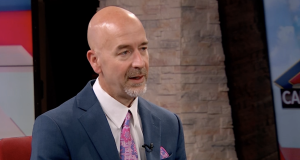State of the State Mid-Year 2024: Schools implementing LEARNS; funding formula change coming?
by September 1, 2024 1:02 pm 620 views

What’s the state of the state in education? Schools are implementing Gov. Sarah Sanders’ LEARNS Act. Legislators are performing the biennial adequacy study that will determine school funding amounts for the next two years. In next year’s legislative session, they could craft a new funding formula.
The sweeping 2023 LEARNS Act made major changes to the state’s education system but left many of the details to the rulemaking process. Secretary of Education Jacob Oliva estimated in an interview that “95%” of the rules are ready. Many had to be completed by July 1.
Among the most notable aspect of LEARNS was its creation of “educational freedom accounts.” Through these, 90% of the state per pupil foundation funding traditionally provided to schools instead goes to eligible families that can use them for qualifying expenses for nonpublic school alternatives. Roughly $7,000 per student will be provided to those families this upcoming second year of the program. Up to 3% of public school students can use them for private schools. Next year, there will be no percentage restrictions, and homeschooled students will be eligible.
As of July 31, about 12,000 students had been approved for the accounts this upcoming year, with those numbers expected to increase. Also, 120 private schools, an increase from last year, had met the requirements to accept students using the accounts. Those numbers also were expected to increase.

Looking forward, Oliva does not expect a mass public school exodus.
“I always think public schools are going to be the first and best choice for most students and families,” he said. “There are strong community connections with public schools, and that goes for generation to generation to generation. A lot of families want their kids to go to the same schools that they went to, and they want them to have the same teachers that they had because they saw that success. The majority of students will always choose their neighborhood public schools. There are some instances where the public school may not have the program for students.”
TEACHER SALARY SUPPORT
Dr. Mike Hernandez, executive director of the Arkansas Association of Educational Administrators, said public school educators are “keeping a watchful eye” on the third year of the program, when the program will be open to all students.
“I don’t think anybody really has a crystal ball to say this is exactly what’s going to happen,” he said. “So it is definitely something that people are thinking about, but what I’ve told schools is they need to be focused on the kids and families that come through their doors, and if they provide a great service and a quality education, then those things tend to take care of themselves.”
Schools are implementing LEARNS’ other changes, including its $50,000 statewide minimum teacher salary. Oliva said lawmakers will provide enough funding for minimum salaries. There also will be enough for districts to provide higher salaries for teachers with more experience, training, and needed skills based on salary schedules they devise.
“We’ve said it from day one, and the governor and the Legislature’s made a commitment from day one, that that funding will be in perpetuity,” he said.
Hernandez said school districts have largely worked through salary issues, including salary schedules as well as federally funded educators who weren’t covered by LEARNS.
READING, MATH REQUIREMENTS
Other changes created by LEARNS include a requirement by the 2025-26 school year that third grade students test proficient in reading or potentially face being retained for a year. Research has shown that third grade grade reading proficiency is a key marker for future academic success. Oliva said he is confident that 90% to 100% of third graders will reach proficiency. In 2023, 32% of third-graders tested proficient in reading in the ACT Aspire exam.
He said “it may be” that a significant number of students are held back for a year, but the law does not require that step. Instead, schools must intervene leading up to that point and then address whatever deficiencies might remain. The state is investing in early literacy skills, literacy coaches, the science of reading, and a unified progress monitoring system so interventions can be provided throughout the school year.
Regardless, he said, “We can’t keep passing students on that aren’t ready to be successful in the secondary level.”
Hernandez said schools are starting to implement LEARNS’ math and literacy requirements. They also are awaiting results from the state’s new ATLAS end-of-the-year exam, which this year replaced the ACT Aspire. Hernandez said he hasn’t heard of any problems with the new exam. It is more geared toward state standards, while the ACT Aspire was more of a college prep/career readiness test.
Hernandez said the incoming data will be informative. Test scores dropped across the state during the COVID pandemic, when many students learned remotely.
“I think schools have worked really hard to try to close the gap, and hopefully we’ll see some of that, but trying to make sure that everybody is on grade level or above is the goal,” he said.
FUNDING FORMULA REVIEW
Oliva said he and the Department of Education are working with legislators and stakeholders through the Legislature’s adequacy funding process. The process typically lasts much of the year before a legislative session and usually results in the numbers being tweaked. Schools typically receive a small annual increase to help pay for rising costs.
A possible major formula change could occur this upcoming legislative session. Rep. Bruce Cozart, R-Hot Springs, who previously chaired the House Education Committee, said the current formula is too one-size-fits-all, has too many supplemental funding categories, and doesn’t fund education properly. The one he’s working on – a draft bill has been written – would provide a base dollar amount per student that would be smaller than the current formula provides. But added to that would be a system of weights based on student characteristics. More money would go for schools with high free and reduced lunch populations and more English language learners. A sparsely populated district would receive extra money for its increased transportation expenses.
“What we’re really trying to do is fund each child as who they are,” he said.
Cozart said the total increase in school funding statewide would be “substantial,” although he doesn’t have the final numbers yet. Only seven traditional schools and four charter schools would receive less money under his proposed formula. The rest would either get the same amount or more, and some would get much more. Small, rural, isolated districts would be the biggest winners unless their enrollments are declining substantially.
His formula also features outcomes-based funding. Schools would receive more money if they have more students meeting test benchmarks or completing career and technical education courses.
The formula is based on Tennessee’s, which he learned about through his relationship with a Tennessee state lawmaker. Cozart has been working on the formula for almost two years and introduced a bill in the 2023 legislative session that came too late to get serious consideration.
Cozart said Oliva and his staff have been supportive of his efforts. Oliva spoke positively about it.
“It’s innovative, and I think when you look at how states fund students, it’s not an exact science,” he said. “And just like we say in LEARNS, a one-size-fits-all approach doesn’t meet the needs of all students and families educationally. A one-size formula that doesn’t have different variables to bring in dollars that students may need to support their learning doesn’t work as well.”
Hernandez said school districts are hopeful about Cozart’s proposal. Many like its possible increased flexibility.
“I think there’s definitely some optimism, and people are very interested to see where this goes,” he said.
Editor’s note: The State of the State series provides reports twice a year on Arkansas’ key economic sectors. The series publishes stories to begin a year and around mid-year to provide an update on the state’s economy. Link here for the State of the State page and previous stories.
